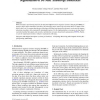Free Online Productivity Tools
i2Speak
i2Symbol
i2OCR
iTex2Img
iWeb2Print
iWeb2Shot
i2Type
iPdf2Split
iPdf2Merge
i2Bopomofo
i2Arabic
i2Style
i2Image
i2PDF
iLatex2Rtf
Sci2ools
VISSYM
2007
2007
Segmentation of DT-MRI Anisotropy Isosurfaces
While isosurfaces of anisotropy measures for data from diffusion tensor magnetic resonance imaging (DT-MRI) are known to depict major anatomical structures, the anisotropy metric reduces the rich tensor data to a simple scalar field. In this work, we suggest that the part of the data which has been ignored by the metric can be used to segment anisotropy isosurfaces into anatomically meaningful regions. For the implementation, we propose an edge-based watershed method that adapts and extends a method from curvature-based mesh segmentation [MW99]. Finally, we use the segmentation results to enhance visualization of the data. Categories and Subject Descriptors (according to ACM CCS): I.4.6 [Image Processing and Computer Vision]: Region growing, partitioning
Anisotropy | Diffusion Tensor Magnetic Resonance Imaging | Rich Tensor Data | VISSYM 2007 | Visualization |
| Added | 30 Sep 2010 |
| Updated | 30 Sep 2010 |
| Type | Conference |
| Year | 2007 |
| Where | VISSYM |
| Authors | Thomas Schultz, Holger Theisel, Hans-Peter Seidel |
Comments (0)

